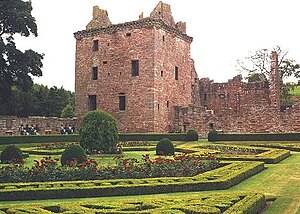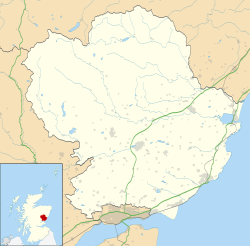Edzell Castle
| Edzell Castle | |
|---|---|
| Near Edzell, Angus, Scotland grid reference NO584691 | |
 Edzell Castle and gardens | |
| Coordinates | 56°48′43″N 2°40′48″W / 56.811827°N 2.68002°W |
| Type | Tower house and courtyard |
| Site information | |
| Owner | Earl of Dalhousie, managed by Historic Environment Scotland |
| Controlled by | Lindsays of Edzell |
| Open to the public | Yes |
| Condition | Ruined |
| Site history | |
| Built | c. 1520 – 1610 |
| Built by | David Lindsay, 9th Earl of Crawford |
| In use | Until 1715 |
| Materials | Old Red Sandstone |
Edzell Castle is a
History
Origins
The first castle at Edzell was a timber
Edzell became the property of a junior branch of the Lindsay family descended from the 3rd Earl, and in 1513 it was inherited by David Lindsay (d. 1558). Around 1520, David Lindsay decided to abandon the original castle, and built a tower house and barmkin, or courtyard, in a more sheltered location nearby. The selection of a site overlooked by higher ground to the north suggests that defence was not the primary concern.[6] David became the Earl of Crawford in 1542, on the death of his cousin the 8th Earl, who had disinherited his own son Alexander, the "Wicked Master". He proceeded to extend the simple tower house, in around 1550, by the addition of a large west range, incorporating a new entrance gate and hall. Lord Crawford also built Invermark Castle, 12 miles (19 km) north of Edzell, possibly as a hunting lodge, at around the same time.[7]
Mary, Queen of Scots, came to Edzell on 25 August 1562. A plan to meet Elizabeth I in England had been abandoned, and she was making a progress to Aberdeen and Inverness.[8]
Sir David Lindsay, Lord Edzell

David Lindsay, the 9th Earl's son, was educated in Paris and
In August 1562, David Lindsay received
Sir David further extended the castle in the late 16th century, with the addition of a large north range with round corner towers. He laid out the garden in 1604, with symbols of England, Scotland and Ireland, to celebrate the

Damage and decline
Edzell was not affected by the campaigns of the Royalist
The castle began to decline around the time of the
The castle saw its last military event in 1746, when a unit of government troops, of the
Later history
The castle remained the property of the earls of Dalhousie, who appointed a caretaker from the 1870s, and built a cottage for him in 1901, which is now in use as a visitor centre. In 1932, the walled garden passed into state care, followed by the rest of the castle in 1935. The castle and garden are currently maintained by
Description

The motte
The motte, still known as Castlehillock, is the only remainder of the first Edzell Castle. It lies 300m south-west of the later castle, by a bend in the West Water, and comprises a low, partially natural mound. The motte is aligned north-west to south-east, and is around 36 metres (118 ft) long by 16 metres (52 ft) across at its broadest point, and around 4 metres (13 ft) high. An outer
The castle
The castle comprises the early 16th-century tower house, the slightly later west range, and the late 16th-century north range. Other buildings to the east and south have now vanished. The red sandstone walls were originally
The four-storey tower house was named the Stirling Tower after the original lords of Edzell, the Stirlings of Glenesk, although it is not old enough to have been built by them.[25] It is 16 metres (52 ft) high, and measures 13 metres (43 ft) by 10 metres (33 ft) on plan. The walls are over 2 metres (6.6 ft) thick at the basement, narrowing to 1.5 metres (4.9 ft) on the first floor.[26] The tower house is entered from the north, via a door protected by "inverted keyhole" shaped gun holes. A slot adjacent to the door would have held a draw-bar, to reinforce the entry, and several mason's marks remain around the door. The hall occupies the first floor, above two vaulted cellars. Marks in the wall show the position of a minstrels' gallery and a timber screen, which concealed a serving area accessed via a narrow stair from the cellar. The broad main spiral stair led up to three further storeys of private chambers, before reaching a cap-house, a small rooftop chamber giving access to a parapet walk.[27] The four corners of the tower have bartizans, or open turrets, and similar projections occur halfway along each wall. The parapet is supported on projecting stones, or corbels, arranged in a pattern of two tiers which alternate, rendering the lower tier purely decorative. Edzell represents an early occurrence of this style, known as chequered corbelling, which became more widespread later in the 16th century.[25]

The two-storey west range contains the main entrance, which enters the courtyard via an arched passage. Above the outside gate are spaces where
The walled garden

In addition to extending the castle, Sir David Lindsay also created Edzell's most unusual feature, the walled garden, or "Pleasaunce".[29] Similar gardens were probably relatively common in Scotland during the Renaissance, but Edzell is a rare survivor.[2] The garden would have provided a retreat from the castle, and was intended to delight, entertain, and instruct Sir David's distinguished guests. It was started around 1604, and shows signs of being hastily completed at his death in 1610.[30]
It is a rectangular enclosure some 52 metres (171 ft) north to south, and 43.5 metres (143 ft) east to west, surrounded by a 3.6 metres (12 ft) high wall. The north wall is part of the castle courtyard, but the remaining three are intricately decorated. The walls are divided by pilasters (now removed) into regular sections, or compartments, each 3 metres (9.8 ft) across. Each compartment has a niche above, possibly once containing statues. Those on the east wall have semi-circular pediments carved with scrolls, and with the national symbols of thistle, fleur-de-lis, shamrock and rose, recalling the
The carved panels

The sets of carved panels depict the seven
The carvings are all based on popular series of engravings, which were often published in pattern books. Nuremberg was the origin of numerous such books, and one may have been brought to Edzell by the miner Hans Ziegler.
| Planetary Deities
Representations of the seven classical deities, associated with the seven planets known in classical times, appear on the east wall. |
Liberal Arts
Figures representing the trivium of subjects (grammar, rhetoric, and logic) which traditionally formed the syllabus of a bachelor's degree, plus the quadrivium which led to a master's degree , are depicted on the south wall.
|
Cardinal Virtues
Personifications of the three Christian virtues (trust, hope and charity), plus the four Cardinal virtues of ancient Greece, are carved on the west wall. |
 |
 |
 |

Buildings and planting
To complement the garden, a bath house and
The planting was recreated in the 1930s. No original plan of the renaissance garden survives, although records show fruit was grown in the 17th century.
Interpretations
The symbolism of the garden, particularly of the carvings, as well as the repetition of
Sir David Lindsay would have been well aware of the symbolic allusions of the carvings. In correspondence with his brother,
Historian
References
Notes
- ^ Simpson & Tabraham (2007), p.1
- ^ a b c McKean, pp.77-78
- ^ Simpson (1930), p.117
- ^ The present village of Edzell, further to the east, was originally named Slateford; it was renamed in the early 19th century when the parish church was moved.
- ^ Simpson & Tabraham (2007), p.25
- ^ Simpson & Tabraham (2007), p.4
- ^ Simpson & Tabraham (2007), p.26
- ^ David Hay Fleming, Mary Queen of Scots (London, 1897), 74, 520.
- ^ Simpson & Tabraham (2007), p.30
- ^ Simpson & Tabraham (2007), p.29
- ^ Calendar State Papers Scotland, vol. 10 (Edinburgh, 1936), p. 132.
- ^ James Dennistoun, Moysie's Memoirs of the Affairs of Scotland (Edinburgh, 1830), p. 78.
- ^ Simpson & Tabraham (2007), p.31
- ^ a b Simpson & Tabraham (2007), p.32
- ^ Simpson (1930), p.118
- ^ Carr, Cecil Thomas (ed.) (1913), pp. cxxvi-cxxvii
- ^ Simpson (1930), p.119
- ^ Simpson & Tabraham (2007), p.33
- ^ Historic Environment Scotland & SM90136
- ^ Historic Environment Scotland & SM137
- ^ Historic Environment Scotland & GDL00169
- ^ Historic Environment Scotland & LB11258
- ^ Simpson (1930), pp.119-120
- ^ Canmore & ID 34998
- ^ a b MacGibbon & Ross, pp.359-366
- ^ Simpson (1930), p.122
- ^ Simpson & Tabraham (2007), pp.12-13
- ^ Simpson & Tabraham (2007), pp.6-11
- ^ Brown (2015), 141-156
- ^ a b Simpson (1930), pp.135-140
- ^ Simpson (1930), pp.152-153
- ^ Simpson (1930), pp.158
- ^ "Music and Justice Rediscovered". Historic Scotland. 9 May 2007. Retrieved 10 April 2008.
- ^ Edzell Castle, The Movie: Souvenir Programme, London Psychogeographical Association, 1994
- ^ McKean, p.147
- ^ Simpson & Tabraham, p.35
- ^ Anderson, Clarence A. "The Art of Memory and Masonry". Retrieved 30 April 2008.
- ^ Glendinning, et al. p.59
- ISBN 0-87728-920-4. p.45
- ^ a b McLean, Adam. "A Rosicrucian/Alchemical Mystery Centre in Scotland". The Hermetic Journal, Vol. 4, No. 11, 1979
Bibliography
- Brown, Marilyn, 'The Patron and the Garden: Sir David Lindsay and Edzell Castle, 1604', Architectural Heritage, vol. 26.1, (November 2015), 141-156.
- Carr, Cecil Thomas, ed. (1913). Select Charters of Trading Companies, A.D. 1530–1707. Bernard Quaritch.
- Glendinning, Miles, MacInnes, Ranald, & MacKechnie, Aonghus (1996). A History of Scottish Architecture, Edinburgh University Press. ISBN 0-7486-0741-2
- Historic Environment Scotland. "Edzell, Castle Hillock (34998)". Canmore. Retrieved 29 October 2021.
- Historic Environment Scotland. "Edzell Castle (SM90136)". Retrieved 26 February 2019.
- Historic Environment Scotland. "Castle Hillock,motte (SM137)". Retrieved 26 February 2019.
- Historic Environment Scotland. "EDZELL CASTLE (GDL00169)". Retrieved 26 February 2019.
- Historic Environment Scotland. "EDZELL CASTLE CUSTODIAN'S HOUSE (LB11258)". Retrieved 26 February 2019.
- ISBN 0-09-473430-5
- ISBN 0-901824-18-6
- McKean, Charles (2004). The Scottish Chateau (2nd edition). Sutton Publishing. ISBN 0-7509-3527-8
- Simpson, W. Douglas (1930). "Edzell Castle" (PDF). Proceedings of the Society of Antiquaries of Scotland, Vol. LXV. Archived from the original (PDF) on 11 June 2007. Retrieved 10 April 2008.
- Simpson, W. Douglas, and Tabraham, Chris (2007). Edzell Castle (2nd edition). ISBN 978-1-904966-34-0
External links
- Historic Environment Scotland: Visitor guide
- Edzell Castle Virtual Tour Archived 28 October 2022 at the Wayback Machine
- 'Geometria' information and colouring sheet created by Thomas Small: [1]

